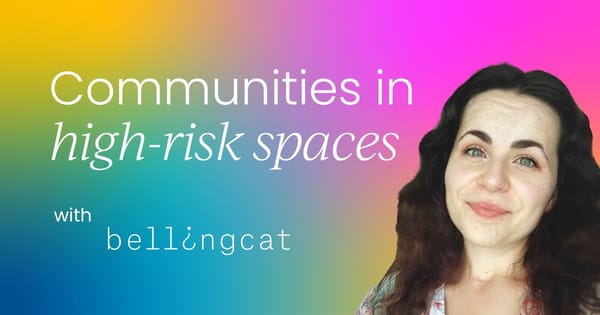When you're building a community in high-risk spaces, where privacy, trust, and security are non-negotiable, the stakes are understandably high. How do you create a space where people feel safe to collaborate, share, and grow, without exposing them to risk?
I help build and support a volunteer community where professional and non-professional researchers collaborate on real-world investigations, such as war crimes and human rights abuses.
In this article, I’ll share what I’ve learned about cultivating safe, purpose-driven communities – where every decision is made with care, clarity, and protection at the core.
Defining the community role
When people ask me what I do, I often find myself pausing for a moment. It’s not an easy question to answer, especially for those unfamiliar with online communities or the professional practices behind them. So, I use analogies to help explain – my current favorite is gardening.
I tell people to imagine walking into a beautiful garden. What they see is the result of careful, thoughtful work: selecting the right plants, creating balance, and ensuring the environment is conducive to growth.
Some plants don’t thrive next to others; some need more light or care. Behind that garden is a gardener, or an entire team of gardeners, doing the invisible labor to maintain it.
That’s what community management feels like to me. I’m not the centerpiece; it’s not about me. It’s about nurturing the space, curating the environment, and making sure the conditions are right for members to thrive together.
Just as some gardens grow wild and self-organized, some communities do, too – and that’s valid. But when you're trying to shape a particular purpose or support structure, having that behind-the-scenes gardener can make all the difference.

What makes a community successful?
This is one of those questions that doesn’t have a universal answer. Success looks different for every online community, and it absolutely should. It depends on what your community is for and what your members hope to get from it.
For me, success starts with clarity – knowing what your goals are, how they align with your organization’s mission, and how your community contributes to them. Without that clarity, it’s pretty difficult to measure progress or make meaningful improvements.
That said, some things are universally important. A successful community is one where people feel safe, welcome, and heard. It’s a space they choose to return to – a place that gives them something valuable for their time and effort. That could be learning, collaboration, support, or even just shared purpose. If people feel like the time they spend in the community matters, that’s already a sign you’re on the right path.
But just as importantly, your community needs to connect back to your organizational goals. If your community is thriving in isolation but isn’t aligned with the larger direction of your organization, that can create long-term friction. Ideally, both should grow together.

Feedback is a cycle, not a checkbox
Collecting feedback isn’t just a task to tick off. It’s a cycle, one that needs to be intentional and transparent. In our community, we run biannual feedback surveys. We’ve found that anything more frequent can lead to survey fatigue, and honestly, it doesn’t give us the space we need to meaningfully act on what we hear.
What matters most to me is what happens after the survey. I spend time reading through the responses, identifying themes, and thinking about what’s realistic to address. Then, we take action. Maybe it’s small, like implementing a centralized events calendar so members can see everything in one place, but those little changes show members that their voices matter.
Equally important is the communication loop. If we can’t act on something, we say so. We explain why. And that transparency builds trust. People are far more willing to share feedback if they know it won’t disappear into a void.
Beyond the surveys, I also pay close attention to informal feedback. That might come through chats, events, one-on-one conversations, or even the tone of a discussion thread. Some of the most insightful suggestions come from these everyday interactions. Not everyone fills out a survey, but that doesn’t mean they don’t have something important to share.
As a community manager, staying tuned in to those moments is a key part of the work.
Managing privacy-first communities
One of the biggest challenges I’ve faced is managing a community where privacy and security are paramount. At Bellingcat, our members work in sensitive investigative spaces. That means everything we do – every tool, every event, every recognition – has to be viewed through the lens of safety.
We can’t do some of the things that are common in other communities. For example, we can’t ask members to share a picture of their desk or the view from their window. That might sound harmless in another context, but in ours, it could pose a serious risk. Similarly, public member spotlights or contributor showcases can’t happen in the usual way, because we don’t want to expose anyone.
Instead, we’ve had to get creative:
- How do you show appreciation without putting people at risk?
- How do you build engagement in a space that can’t be loud or highly visible?
These are questions I’m constantly working through. They’ve pushed me to rethink what meaningful recognition and participation look like. And in a way, that’s been an opportunity: to center care and protection in everything we do.
Lessons from earlier stages
Looking back, if I could do something differently professionally, it would be tying our community strategy more tightly to the organization’s broader goals from day one. In the early days of community building, especially when the profession was still emerging, many organizations jumped in without a clear strategy. There was excitement, sure, but often without clarity on how the community would fit into the bigger picture.
In some ways, I think this was a widespread challenge in our field. Community work was often seen as experimental or siloed, rather than integral to organizational success. Over time, though, that’s changing. We’re having more conversations about alignment, measurement, and strategy – and I think that’s helping us close those early gaps.
Now, when I approach any new initiative, I start by asking:
- How does this support the mission?
- How does it benefit both the members and the organization?
That alignment is everything.

Advice for new community professionals
If you’ve just entered the world of community management, my advice is to stay open – and not just to ideas, but to job titles, too.
Community work often shows up in places you might not expect. You might have “community” in your title, or you might not. You could be in events, support, advocacy, research, or even marketing, and still be doing deeply community-centric work.
So don’t box yourself in. If you’re passionate about building connections, listening closely, and shaping spaces where people can thrive, your skills are valuable in many roles. Likewise, if you’re already in a community and looking to grow, know that there are paths forward even if your organization doesn’t have a huge community team.
What I love most about this field is that we’re always learning. Every community is different. Every space requires its own rhythm. And that means you’re constantly evolving, which is exactly what makes the work so rewarding.
A few fun reflections
If I could invite a fictional character into our community, it would probably be Sherlock Holmes. Given the investigative nature of our work, he fits perfectly... athough I imagine he’d be a rather intense member to manage!
And if we had a theme song? I once asked our members this question during a live session, and the answer that stuck with me was the Pink Panther theme. It’s got that playful mystery, the curious spirit, and a bit of cheekiness, all of which reflect who we are and how we operate. It’s a little unexpected, but that’s part of the charm.



 6 min read
6 min read
 Follow us on LinkedIn
Follow us on LinkedIn





